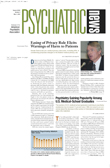Psychiatric researchers have arduously worked to understand how and why mental illnesses such as schizophrenia strike apparently healthy people in the prime of their lives. Recently, their efforts have led to a previously unknown genetic link that may answer some of these questions, according to Daniel Weinberger, M.D.
Weinberger, who is chief of the Clinical Brain Disorders Branch of the Intramural Research Program at the National Institute of Mental Health (NIMH), spoke at a symposium held by the National Alliance for Research on Schizophrenia and Depression in New York City in January.
He first addressed some of the questions researchers confront when they search for the genetic basis of certain psychiatric disorders. For instance, how many individual genes are there that may cause a person to become susceptible to developing a mental illness? How much does one gene by itself contribute to the likelihood that a person will develop a mental illness, and ultimately, how do certain genes influence susceptibility in those who inherit them?
The answers to these questions don’t come easily, in part because researchers haven’t identified any one gene that is definitively linked to a certain mental illness. In other diseases, there are direct genetic links. For instance, “fate” genes, which are implicated in Huntington’s disease or cystic fibrosis, if inherited, determine that a person will manifest these illnesses in his or her lifetime.
But genes associated with mental illness are “risk” or “susceptibility” genes, similar to those for other complex yet common medical conditions such as cancer. When combined with environmental factors, for instance, risk genes can cause someone to become more vulnerable to developing a mental illness.
Search for Fool’s Gold
When investigators search for genes associated with mental illness, they typically use more than one approach. One is the traditional linkage approach in which researchers follow the transmission of certain traits within families and look for relationships with nucleotide markers that identify pieces of DNA on a person’s genome. According to Weinberger, researchers can then trace the inheritance of those pieces of DNA within families where a disease is also inherited in a recognizable pattern. It is then possible to examine the link between the inheritance of this piece of DNA and the inheritance of the illness.
Another approach, the candidate-gene approach, Weinberger likened to a search for “fool’s gold,” because like the fabled gold diggers who stumbled upon iron or copper pyrite and mistook it for the real thing, researchers sometimes think they have found a genetic link but haven’t. These researchers set out with some knowledge about the biology of the illness and the biology of the gene and use this knowledge to see whether the illness and gene are associated. However, Weinberger said, sometimes the researchers don’t have enough information about either, and this makes the search more difficult.
The absence of a direct link between genes and mental illness often proves frustrating to researchers. “The problem is that genes do not encode panic attacks,” said Weinberger. “Genes do not encode depression. Genes do not encode hallucinations or delusions, nor do they encode thoughts or how you react to things.” He said that genes encode simple molecules in cells, usually proteins, and these proteins change how a cell responds to stimuli in its environment.
In a broader sense, the chain of events goes something like this: Genes affect the behavior of cells, which in turn affect the complex physiology of the brain, producing some of the behaviors manifested in a person with mental illness.
Cognitive-Processing Deficit Apparent
To see whether the brain processes that make working memory possible are affected by the cellular effects of certain genes, a number of studies have been conducted that test certain brain functions in people with and without schizophrenia.
People with schizophrenia do not process information needed for certain memory-related tasks as efficiently as do people without schizophrenia, Weinberger said, and this has been illustrated clearly in brain-imaging studies. People with schizophrenia use a much larger portion of their brains to memorize a phone number, for instance, than do people without schizophrenia.
This cognitive-processing defect is found in the dorsolateral prefrontal cortex, and Weinberger and his colleagues at NIMH have found through their own investigation that the defect is present in people who have risk genes for schizophrenia. “This defect in prefrontal brain function is not only a cardinal feature in patients with schizophrenia, but it is also related to being genetically at risk for developing this illness,” Weinberger said at the NARSAD meeting.
In their research, Weinberger’s team discovered a gene that may influence how working-memory information is processed in the prefrontal cortex because it regulates the activity of dopamine in prefrontal cortex synapses. Dopamine plays a pivotal role in the responsiveness of cells in the prefrontal cortex and their actions in working memory. The gene codes for an enzyme, catecho-O-methyltransferase (COMT), that breaks down dopamine after it is secreted into the synapse.
The gene is found on chromosome 22 and is made up of 3,651 letters of the genetic-code alphabet. The COMT gene has one letter that varies depending on the type of gene that is inherited, and this letter affects the enzyme and its activity. The gene has two common forms, or alleles, Val and Met. As with any gene, people inherit one allele from each parent. The two alleles result from a single base substitution that replaces the amino acid methionine (Met) and Valine (Val).
To test working memory in research subjects, Weinberger and colleagues administered a card-sorting task to 181 subjects with schizophrenia, 219 of their nonschizophrenic siblings, and 75 normal controls. They found that subjects who inherited the Val/Val allele performed worse on the card-sorting test than those who inherited the Val/Met or Met/Met alleles. The researchers concluded that the Val allele, by reducing prefrontal dopamine activity, adversely affects prefrontal function compared with the Met allele. Weinberger’s team reported these findings in the May 29, 2001, Proceedings of the National Academy of Sciences.
“Overall, this single gene variation predicts about 4 percent of the normal human variation in working memory,” said Weinberger. “This, for a single gene, is quite a dramatic effect on a very important aspect of human cognition,” he said.
How does the gene affect working memory? Weinberger explained that the variation in the COMT gene has a profound impact on the structural biology of its protein, which in turn has an effect on dopamine-mediated prefrontal function.
Weinberger’s team also looked at transmission of the Val allele to children of people with schizophrenia to see whether it was more common in this subgroup. When they examined 104 pairs of parents of patients with schizophrenia, they found that the Val form of the COMT gene was transmitted to children who eventually developed schizophrenia more often than would be expected by chance—75 times for Val and 51 times for Met. They concluded that inheriting two copies of the Val allele accounted for a 1.8-fold increased risk for schizophrenia in the general population.
Weinberger said that this increase in risk may not seem very large, but when combined with other risk factors, it can make a difference. “All of a sudden, if you add up enough factors with similar risk bias, you might explain the lion’s share of the risk to manifest the illness,” he added.
Weinberger calculated that about 200,000 people in the United States would not have schizophrenia if they had not inherited the Val allele, based on its prevalence in the population.
In other words, Weinberger explained, this additional risk factor is enough to cause some people to “fall off the edge” and manifest symptoms of schizophrenia when they wouldn’t have if they had not inherited the Val form of the COMT gene. ▪

